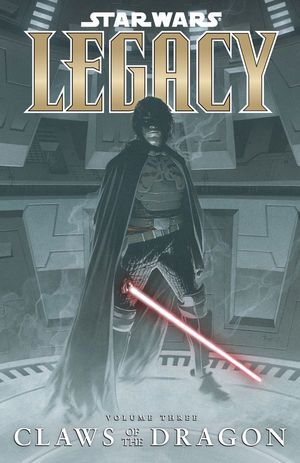
In volume 3, we get the name of the Sith master, A'sharad Hett. For those who've been following various other Star Wars books, set in different time lines, this is no stranger to the Star Wars universe. Indeed, by using sith techniques to prolong life and spending time in statis, Darth Krayt has managed to live through the Clone Wars, the movie's time line, and this time line, set over a hundred years after the movies.
This allows the authors to use the expanded universe to its fullest and bring in individuals that the reader may care about. It also allows the authors to use various other trappings and add little so called Easter Eggs all through the series allowing the reader to enjoy the ones they like and skip over those they don't know.
In a role playing game, this has to be done off of previous experiences in the actual game itself. If none of the players are familiar with any of the old Non-Player Characters or haven't played with your gaming group before, bringing out some of the most interesting and well loved characters of the past campaigns as villains will have no shock value and no real emotional impact.
In the 'greater' realm of the shared experience on the other hand, the greater experience of the Dungeons and Dragons game, Wizards of the Coast does this all the time ranging from book titles, to updating magic items, to updating concepts that fall into and out of favor. For example, demons. During second edition, demons and devils were given the boot, the demon lords removed from the game until they were brought back later on, still during second edition, and even allowed players to have a huge potential role in the bringing back of one of the most famous of the big bads, the demon prince of the undead, Orcus himself.
By using the wider mythology of the Dungeons and Dragons game itself, Wizards of the Coast and back in the day, TSR were able to try and bring bridges to gap not only the edition differences, but also the differences in years from when various people may have started playing the game. This allows people who haven't played with one group to still have some background elements in common thanks to the shared background of the game, to share those elements in the game that nether has played before.
When planning out encounters, and using characters that may make multiple apperances, let synergy by your guide. Nihl was one of the Sith that killed Cade's father and cost Cade's mentor his arm. Here, Cade cuts off Nihl's arm. Tit for tat but also synergy in how wounds dealt may come back. Showcase how past actions may be reflected in the game as it continues to unwind.
This doesn't always have to be true though. For example, many characters have a masked identity. This ranges from the modern era of Super Heroes and Pulp Heroes to older heroes like Zorro. What if the players have an ally whose actually an enemy or an enemy that's actually an ally? Masks, methods of preventing detection, and other methods, can go a long way in concealing someone's identity. Give the players a start next time they hire on a torch bearer who is actually the mayor of the town.
For combat, don't forget the social aspects of it. When Cade fights against the Sith master, the Sith taunts Cade numerous ways. When Cade returns the favor, it drives the Sith into a near berserk rage that makes him forgo any style or panache and costs him the fight and drives the Sith lord onto a horrible plot for revenge latter. If the players are able to get under the skin of their enemies, give them some type of bonus. Perhaps the bad guy doesn't use his best attack. Perhaps he only targets one of the players instead of all of them. Perhaps he targets the rogue with the glib tongue even though the fighter gets a free attack by doing so. Don't let the game mechanics dictate everything. Let combat unflow through the use of social and martial methods.
In terms of character opportunities and role playing potential, Cade Skywalker works with the Sith while trying to determine what he is going to do. Doing so is potentially dangerous for anyone as the whole Force and Dark Side bit tends to be addicting. As the Darth master himself notes, "What we pretend to be we often become."
In terms of character planning, the author shows the readers a recuse attempt being crafted and how the characters go through equipment and use their skills to insure that no stone goes unturned. It works well. This is not to say that there should never be an issue, some surprise, some last minute problem that crops up, but if the players are smart and spend the time and resources and back those plans up with the abilities, allow that planning to go through.





No comments:
Post a Comment